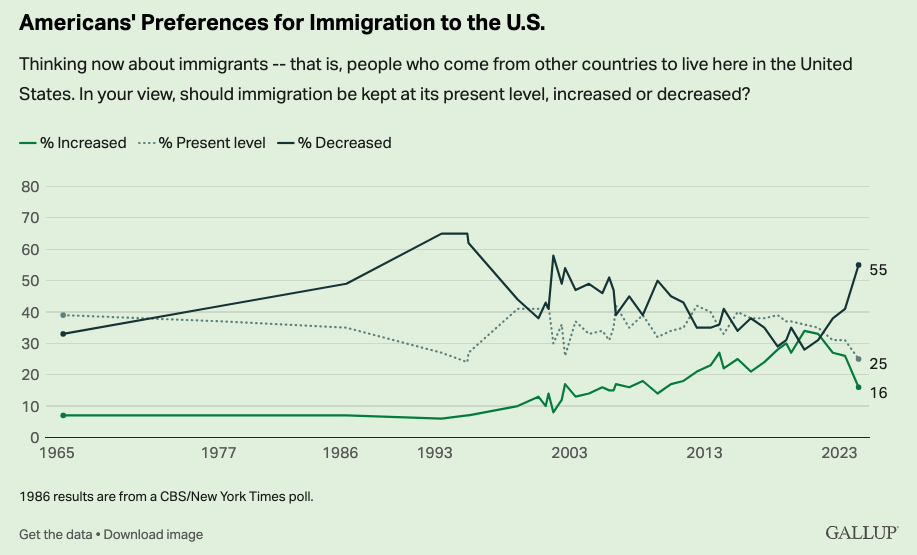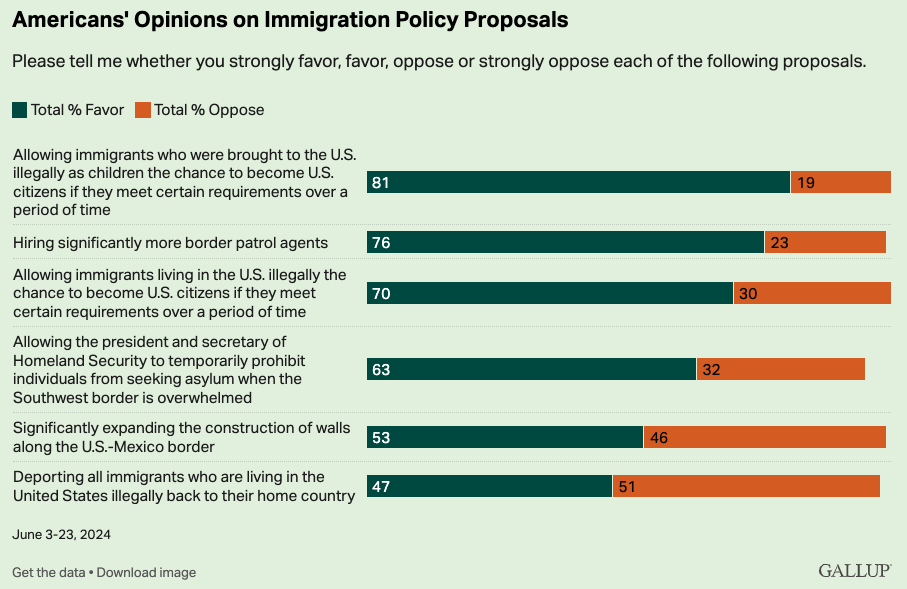The percentage of Americans who want immigration levels to decrease has risen sharply in the past year despite the nation’s urgent need for foreign-born workers in agricultural and other labor industries.
A Gallup poll released this month found 55% of U.S. adults support a reduction in immigration compared to 44% who wanted a reduction in 2023. The decline marked the first time since 2005 that a majority of respondents preferred a reduction, and it was the highest percentage since the 58% documented in 1993 and 1995.
At the same time, Gallup reported a drop in the share of Americans who want to see more immigration, from 26% last year to 16% when the latest survey was conducted June 3-23. Those who prefer to keep immigration levels steady decreased 6 percentage points to 25% during the past 12 months.
Meanwhile, 42% of survey respondents described the situation at the U.S.-Mexico border as a crisis and 35% called it a major problem.

“The shifts in attitudes have come after monthly illegal border crossings reached record levels late last year,” the Gallup report notes. “They have dropped significantly since then but remain above most monthly pre-pandemic totals. Gallup’s monthly measure of the most important problem facing the country finds immigration consistently ranking among the top issues this year.”
But government, industry and migrant advocacy groups warn the nation’s economic vitality will continue to suffer significant setbacks if immigration declines or even remains steady.

Stephanie Ferguson
“We hear every day from our member companies — of every size and industry, across nearly every state — that they’re facing unprecedented challenges trying to find enough workers to fill open jobs,” said Stephanie Ferguson, director of global employment and special initiatives with the U.S. Chamber of Commerce.
“We have 8.1 million job openings in the U.S. but only 6.8 million unemployed workers.”
“Right now, the latest data show we have 8.1 million job openings in the U.S. but only 6.8 million unemployed workers. We have a lot of jobs but not enough workers to fill them. If every unemployed person in the country found a job, we would still have millions of open jobs,” she said.
The U.S. Bureau of Labor Statistics reported in May that foreign-born workers comprised a record high 18.6% of the civilian workforce in 2023, up from 18.1% the year before.
“In 2023, foreign-born workers were more likely than native-born workers to be employed in service occupations; natural resources, construction, and maintenance occupations; and in production, transportation, and material moving occupations,” the report said. “Foreign-born workers were less likely than native-born workers to be employed in management, professional, and related occupations and in sales and office occupations.”
And those workers are projected to be a major boost to the U.S. economy, according to a July report by the Congressional Budget Office. “Over the next decade, in CBO’s projections, GDP is greater than it would have been if the (immigration) surge did not occur. In all, projected nominal GDP over the 2024–2034 period is $8.9 trillion greater because of the surge in immigration.”

Immigrants arriving since 2021 are expected to pay $788 billion in payroll and income taxes and contribute $1.2 trillion in federal revenues during the next 10 years. The surge may also boost the size of the labor force, reduce unemployment and enhance overall productivity, CBO said.
An agricultural labor task group in the U.S. House of Representatives issued a report in March acknowledging the economic challenges some U.S. employers are experiencing due to labor shortages.
“The agricultural sector is currently facing urgent challenges caused by producers’ lack of access to an adequate workforce.”
“The agricultural sector is currently facing urgent challenges caused by producers’ lack of access to an adequate workforce. This has been a problem for decades, and it continues to worsen. U.S. farmers are already reeling from record-high production costs that have translated into thin and negative margins. The inability to find and hire workers is only exacerbating this negative trend.”
The working group recommended expansion of the H-2A seasonal work visa to include continuous employment in agricultural and livestock operations for up to three years with pay reflecting “real world wages.” Workers also would be allowed to travel home and return to the U.S. if they desire.
“One thing that has become clear is the need for dairy products, meat processors, sugar processors, forestry, ranchers, and others to have access to a steady and legal workforce,” the report says.
President Biden sought to partially address those needs with a June 18 order granting employment protections to Dreamers and work permits to certain undocumented immigrants already in the U.S. Immigration rights groups praised the action but added more is needed.
“President Biden’s action to extend work permits for long-term immigrant spouses is morally right, economically sound and politically smart,” said Rebecca Shi, executive director of the American Business Immigration Coalition, an alliance of more than 1,400 CEOs and employers across the nation.

Napoleon Nelson
“This is essential,” said State Rep. Napoleon Nelson of Pennsylvania. “We’re talking about jobs and economic productivity. We can talk about the increasing tax revenues that would come to [the] commonwealth and come to the nation through expanded work visas. This is a very important step and more must continue to come.”
But advocates are concerned current and future economic growth could be undone if Christian nationalists succeed in dismantling immigration through the implementation of Project 2025, a 900-page playbook to be used if Donald Trump wins a second term in the White House.
The right-wing blueprint “reflects a meticulously orchestrated, comprehensive plan to drive immigration levels to unprecedented lows,” states a report by the Niskanen Center, a Washington, D.C.-based think tank focused on civil liberties, environmentalism and immigration.
“These proposals circumvent Congress and the courts and are specifically engineered to dismantle the foundations of our immigration system,” that report says.
The project’s recommendations include denying legal status to 500,000 Dreamers, excluding wider groups of immigrants from temporary work visa programs and disqualifying Americans from federal housing subsidies if they live with anyone other than a U.S. citizen or legal permanent resident.
“They are designed to cripple the existing immigration system without regard for the extraordinarily harmful effects on the health and wealth of our country.”
The proposals are a radical departure from traditional conservative immigration priorities such as promoting assimilation and merit-based immigration, Niskanen said. “Instead, they are designed to cripple the existing immigration system without regard for the extraordinarily harmful effects on the health and wealth of our country. They would weaken our nation’s prosperity and security and undermine the vitality of our workforce, with far-reaching consequences for future generations of Americans.”
At the same time, Trump and his team are drafting plans to deport millions of unauthorized immigrants annually, The New York Times reported.
“To help speed mass deportations, Mr. Trump is preparing an enormous expansion of a form of removal that does not require due process hearings,” the Times explained. “To help Immigration and Customs Enforcement carry out sweeping raids, he plans to reassign other federal agents and deputize local police officers and National Guard soldiers voluntarily contributed by Republican-run states.”
But most of those Americans surveyed by Gallup, however, did not express such harsh approaches. The poll found 70% of U.S. adults “favor allowing immigrants who entered the country illegally a chance to become U.S. citizens if they meet certain requirements over a period of time. Support is even higher — 81% — for a similar policy for those brought to the U.S. illegally as children.”


